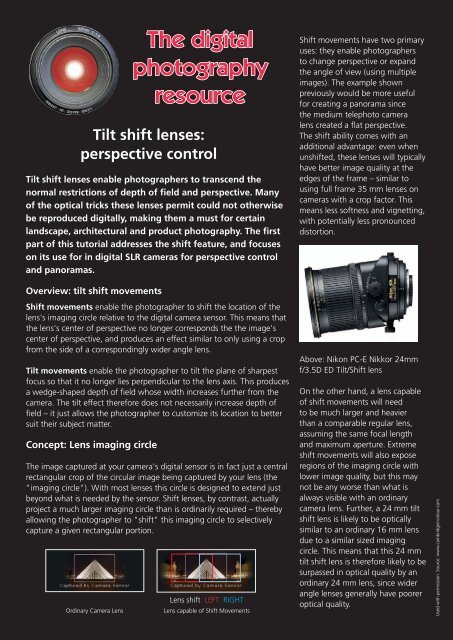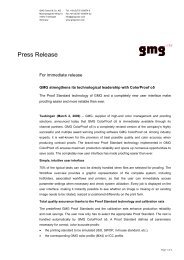The digital photography resource Tilt shift lenses: perspective control Tilt shift lenses enable photographers to transcend the normal restrictions of depth of field and perspective. Many of the optical tricks these lenses permit could not otherwise be reproduced digitally, making them a must for certain landscape, architectural and product photography. The first part of this tutorial addresses the shift feature, and focuses on its use for in digital SLR cameras for perspective control and panoramas. Overview: tilt shift movements Shift movements enable the photographer to shift the location of the lens's imaging circle relative to the digital camera sensor. This means that the lens's center of perspective no longer corresponds the the image's center of perspective, and produces an effect similar to only using a crop from the side of a correspondingly wider angle lens. Tilt movements enable the photographer to tilt the plane of sharpest focus so that it no longer lies perpendicular to the lens axis. This produces a wedge-shaped depth of field whose width increases further from the camera. The tilt effect therefore does not necessarily increase depth of field – it just allows the photographer to customize its location to better suit their subject matter. Concept: Lens imaging circle The image captured at your camera's digital sensor is in fact just a central rectangular crop of the circular image being captured by your lens (the "imaging circle"). With most lenses this circle is designed to extend just beyond what is needed by the sensor. Shift lenses, by contrast, actually project a much larger imaging circle than is ordinarily required – thereby allowing the photographer to "shift" this imaging circle to selectively capture a given rectangular portion. Lens shift LEFT RIGHT Ordinary Camera Lens Lens capable of Shift Movements Shift movements have two primary uses: they enable photographers to change perspective or expand the angle of view (using multiple images). The example shown previously would be more useful for creating a panorama since the medium telephoto camera lens created a flat perspective. The shift ability comes with an additional advantage: even when unshifted, these lenses will typically have better image quality at the edges of the frame – similar to using full frame 35 mm lenses on cameras with a crop factor. This means less softness and vignetting, with potentially less pronounced distortion. Above: Nikon PC-E Nikkor 24mm f/3.5D ED Tilt/Shift lens On the other hand, a lens capable of shift movements will need to be much larger and heavier than a comparable regular lens, assuming the same focal length and maximum aperture. Extreme shift movements will also expose regions of the imaging circle with lower image quality, but this may not be any worse than what is always visible with an ordinary camera lens. Further, a 24 mm tilt shift lens is likely to be optically similar to an ordinary 16 mm lens due to a similar sized imaging circle. This means that this 24 mm tilt shift lens is therefore likely to be surpassed in optical quality by an ordinary 24 mm lens, since wider angle lenses generally have poorer optical quality. Used with permission. Source: www.cambridgeincolour.com
11 The latest technical information for <strong>GMG</strong> software. Is your software up-to-date? <strong>GMG</strong> <strong>Color</strong>Proof latest v5.2.3.64 SP3 Operating system Microsoft Windows 2003 Server, 2008 Server, XP Professional, Vista, Windows 7 (32-bit, 64-bit) Supported output devices Epson Stylus Pro 4000, 4400, 4450, 4800, 4880, 7400, 7450, 7600, 7800, 7880, 7900, WT7900, 9400, 9450, 9600, 9800, 9880, 9900, 10600, 11880, HP Designjet 130, 1050, 1055, 4000, 5000, 5500, Z2100, Z3100, Z3200, Z6100, Canon imagePROGRAF iPF 6300, 6350, 8300, 9100 and other inkjet and laser printers Measuring instruments support Current models from X-Rite incl. DTP70, Spectrolino/SpectroScan, EyeOne, iO, iC<strong>Color</strong>, iSisMeasurements from other devices can be accepted in form of IT8 measurement data. File formats PS, PDF, PDF/X, TIFF, TIFF-IT (CT/LW composite and separated) TIFF-LZW/Packbits, Scitex CT/LW (Kodak), Bitmap-LEN (EskoArtwork), Delta Documents and Lists (Heidelberger Druckmaschinen), Photoshop® DCS/EPS (Adobe), JPEG, etc. Workflow integration Interfaces to Delta and MetaDimension, Nexus and Barco, Brisque, Prinergy, ApogeeX, CelebraNT, TWiST, Harlequin Supported profiles Proof Standards and calibration sets, incl. MXC, MX3, MX4 and ICC profi les (incl. multicolor), support of ICC specifi cation V2 and V4 Spot color databases Support of unlimited process and spot color separations in pixel data, support of 27 spot color separations in PDF fi les; support for spot color systems, such as Hexachrome ® RIP Adobe PDF Print Engine technology and full PDF/X 1a, PDF/X-3, PDF/X-3 support. <strong>GMG</strong> DotProof module of <strong>Color</strong>Proof latest v5.2.3.64 SP1 Features Reproduction of the original screen ruling, screen angle and dot shape of the image setter RIP; incorporation of the tone reproduction curve and dot gain; special computer algorithms for dot-for-dot reproduction; high throughput due to optimised adaptation of the image setter data to the resolution of inkjet printers; Supported formats PS, PDF, PDF/X, TIFF (LZW/Packbits), TIFF-IT (CT/LW composite and separated), TIFF- Bitmap (LZW/Packbits), Scitex CT/LW and Assign (Kodak), Bitmap LEN and ArtPro AIF, Delta Documents and Lists, Presstek, Photoshop DCS/EPS, JPEG. DotProof functionality only supported with 1bit formats or PDF/PS/EPS using built-in DotCreator Supported profiles MX3, MX4, MX5, ICC profiles <strong>GMG</strong> FlexoProof / FlexoProof XG v5.2.2.2 SP1 Operating system Microsoft Windows 2003 Server, 2008 Server, XP Professional, Vista, 7 (32/64bit) Supported output devices Epson Stylus Pro 4000, x400, x450, x800, x880, x600, x900; HP Designjet 130, 1050,1055, 4000, 5000, 5500, Z3100, Z3200, Z6100; Canon imagePROGRAF W6400, W8400 and other inkjet and laser printers Supported profi les Proof Standards and calibration sets, incl. MXC, MX3, MX4, MX5 and ICC profi les, support of ICC specifi cation V2 and V4 <strong>GMG</strong> ProofControl latest v1.5.0.7 Operating system Microsoft Windows 2003 Server, 2008 Server, XP Professional, Vista, 7 (32/64 bit) Features Reliable color communication through proof inspection and verifi cation. Complete quality control based on a defi ned standard. Reproducible print quality and high customer satisfaction. Incorporated industry standards; user- defi ned quality criteria. Self-adhesive label with information on production-relevant data and measured values. Support of DeltaH for better control of exact reproduction of neutral gray on proof. Implemented printing standards Target values to ISO Offset 27L-32L and 39L-43L; ISO Newspaper 26 and 30; 3DAPv2; GRACoL 2006 #1; SWOP 2006 #3 and #5; PSR Gravure (ECI) HWC, LWC, MF and SC; evaluation to new and old ISO 12647-7 tolerances possible Supported measuring instruments X-Rite i1 with and without UVcut fi lter (device also suitable for monitor calibration), X-Rite DTP20 (Pulse) with and without UV cut-off fi lter, Integrated measuring device of the HP Zx100 series . INFO: not all standards available for all measurement devices Output device Zebra, Dymo <strong>GMG</strong> <strong>Color</strong>Server latest v4.7.2.4 with Service Pack 2 Operating system Microsoft Windows 2003 Server, 2008 Server, XP Professional, Vista, 7 (32/64bit) Features RGB-to-RGB, RGB-to-CMYK, CMYK-to-CMYK, CMYK-to-RGB conversion, CMYK reseparation, TAC reduction within a color space, automatic scaling (adjustment of the resolution), 3D dynamic sharpening, separate processing of pixel and vector elements within a document, PDF-to-PDF conversion, including scaling, sharpening and separation of embedded RGB data. Further processing of PDF documents as PDF/X-3 or X-1 document including incorporation of the output intent. Profi le support MX4, ICC Input formats PDF (up to 1.7), PostScript, TIFF, TIFF-IT, JPEG, CT/LW, EPS (Photoshop® pixel data) Output formats PDF (with PDF-to-PDF), TIFF, TIFF-IT, JPEG, CT/LW, EPS (Photoshop® pixel data) Profi les for common standards PSR, ISO, SWOP, GRACoL, Japan Magazine & Publishing Standard <strong>Color</strong> (JMPA color), 3DAP, sRGB, AdobeRGB and ECI-RGB (v1 and v2). <strong>GMG</strong> PrintControl v2.0.4 <strong>GMG</strong> RapidCheck latest v2.0.4 Operating system Microsoft Windows 2003 Server, 2008 Server, XP Professional, Vista, 7 (32/64bit) Product features Measurement based evaluation and determination of optimal print densities and CTP dot gain curves for ISO-conform printing and also monitoring of ongoing conformity. Advantages With the included Profi leEditor the user may make his own printing standard. <strong>Color</strong>imetric values for primaries, secondaries, and paper may be specifi ed, as well as TVI with tolerances. In addition to classical monitoring of trapping and its display in percent, it is also possible to compare color deviations colorimetrically with the ISO target values on the a*/b* axes. The database provided allows the user to classify all papers in use, and compare them with the ISO 12647 paper classes and with each other. The combination of the “Print Contrast” function and the optimum density values guarantees maximum print contrast in the given density range. Supported standards ISO 12647-2 (with all 5 paper types), ISO 12647-3 with the specifi cations for Newspaper 26 and 30, in-house standards Supported media wedges Three versions of the ECI-bvdm Gray wedges, PCPro Control Strip, RapidCheck media wedge, and user-defi ned media wedges Supported measuring i1, DensiEye, SpectroEye, DTP 500 series and iCPlate (platereader) from X-Rite. Import/Export options Data exchange between <strong>GMG</strong> PrintControl Pro and <strong>GMG</strong> RapidCheck <strong>GMG</strong> InkOptimizer latest v4.7.2.4 with Service Pack 2 Operating system Microsoft Windows 2003 Server, 2008 Server, XP Professional, Vista, 7 (32/64bit) Input formats PDF (to 1.4), PostScript, Tiff, Tiff IT JPEG, CT/LW, EPS (Photoshop pixel data) Output format PDF (with PDF-to-PDF), TIFF, TIFF/IT, JPEG, CT/LW; EPS (Photoshop pixel data) Supplied profi les ISO Fogra 29L, 39L, GRACoL7 <strong>GMG</strong> SmartProfi ler v1.5.05 with Service Pack 2 Operating system Microsoft Windows 2003 Server, 2008 Server, XP Professional, Vista Profi le support <strong>GMG</strong> MX3, MX4 and ICC profi les, support of ICC specifi cation V2 and V4 <strong>GMG</strong> releases frequently new profi les. A PDF listing profi les installed with your software version is located in <strong>Color</strong>Proof\Reference Profi les\. <strong>GMG</strong> RIP Server Standalone v4.7.0.14 Requirements As <strong>Color</strong>proof 5.2 Hardware requirements We recommend at least the following computer hardware for running <strong>GMG</strong> RIP Server Standalone: Intel Core i5 processor 4 GB RAM, 250 GB HD, Videocard / Display min. 1024 x 768 dpi resolution, 32-Bit, DirectX 10 support, 256 MB RAM, DVD-ROM, min. 2 x USB 2.0, Network adapter, internet access

















